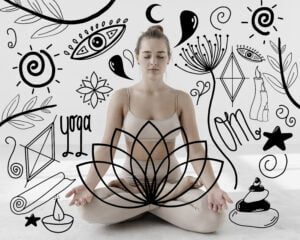Mind-Body Fitness
Do you ever feel stressed or anxious? Sometimes, our minds and bodies need a little extra care to help us feel better. That’s where mind-body fitness comes in! Mind-body fitness is all about using movement and wellness practices to help us feel healthier and happier. It’s like giving ourselves a big, warm hug from the inside out. We can do things like yoga, meditation, and mindful breathing to bring balance to our minds and bodies. These practices can help us find inner peace, take care of our emotions, and even connect with nature. So, let’s explore the wonderful world of mind-body fitness and learn how to integrate movement and wellness into our lives!

Mind-Body Fitness
Understanding Mind-Body Connection
Your mind and body are closely connected. This means that what you think and feel can affect your physical well-being, and how you move and take care of your body can also impact your mental health. When you have a good mind-body connection, it means that you are aware of how your thoughts, emotions, and actions influence each other.
Benefits of Mind-Body Fitness
Engaging in mind-body fitness activities can have many benefits for both your mind and body. It can help reduce stress, improve focus and concentration, enhance mood, increase self-awareness, and promote overall well-being. When you take care of your mind and body together, you may find that you have more energy, feel happier, and have a greater sense of balance in your life.
Incorporating Mindfulness into Fitness
Mindfulness is about being fully present and aware of the present moment. When you are mindful, you pay attention to your thoughts, feelings, and sensations without judgment. You can incorporate mindfulness into your fitness routine by being fully present during exercise, paying attention to your breath, and noticing how your body feels. This can help you stay focused, prevent injuries, and enjoy your workouts more. Remember to listen to your body and give yourself permission to rest or modify your exercise routine if needed.
Integrating Movement and Wellness
Importance of Physical Movement
Physical movement is essential for your overall well-being. It not only helps to keep your body strong and healthy but also has a positive impact on your mental health. Regular physical activity can improve your mood, reduce symptoms of anxiety and depression, and increase your energy levels. It can also help you maintain a healthy weight, prevent chronic diseases, and improve your sleep quality.
Types of Mind-Body Exercises
There are many different types of mind-body exercises that you can try to integrate movement and wellness into your life. Yoga, tai chi, qigong, and Pilates are some examples of mind-body exercises. These exercises combine physical movement with mental focus and breath awareness to help improve your strength, flexibility, balance, and overall well-being. Find a type of exercise that you enjoy and that suits your needs and preferences.
Finding the Right Movement Practice for You
Everyone is different, so it’s important to find a movement practice that works best for you. Consider your interests, preferences, and any physical limitations or health conditions when choosing a type of exercise. It’s also helpful to try different activities and see what feels good for your body and mind. Remember that it’s okay to start slow, take breaks when needed, and listen to your body’s signals. The goal is to find a movement practice that you enjoy and that you can sustain in the long term.

Inner Peace and Mindfulness
Exploring the Power of Inner Peace
Inner peace is a state of calmness, balance, and tranquility within yourself. It is a sense of harmony and contentment that comes from deep within. When you have inner peace, you are more likely to experience joy, gratitude, and a greater sense of well-being. Inner peace can also help you navigate through challenges and stressful situations with more resilience and clarity.
Practicing Mindfulness in Daily Life
Practicing mindfulness in your daily life means being fully present and engaged in each moment. It involves paying attention to your thoughts, feelings, and sensations, as well as the world around you. Mindfulness can be practiced in various activities, such as eating, walking, or simply taking a few minutes to sit quietly and focus on your breath. By practicing mindfulness, you can cultivate a greater sense of calmness, clarity, and inner peace.
Mindful Movement for Stress Reduction
Mindful movement refers to engaging in physical activities with full awareness and presence. It involves paying attention to the sensations and movements of your body, as well as your breath and thoughts. Engaging in mindful movement exercises, such as yoga or tai chi, can help you reduce stress and anxiety by promoting relaxation and grounding. When you practice mindful movement, you give yourself the opportunity to release tension, connect with your body, and find inner calmness.
Meditation Techniques
Introduction to Meditation
Meditation is a practice that involves training your attention and awareness to achieve a mentally clear and emotionally calm state. It is a way to quiet the mind and cultivate a sense of inner peace and relaxation. There are different meditation techniques, but they all involve focusing your attention on a specific object, such as your breath, a word, or a mantra.
Different Meditation Styles
There are various styles of meditation, each with its own unique focus and approach. Mindfulness meditation is one of the most popular styles and involves paying attention to the present moment without judgment. Loving-kindness meditation focuses on developing feelings of compassion and kindness towards yourself and others. Transcendental meditation uses specific mantras to help you reach a state of deep relaxation and inner peace. It’s important to explore different styles and find the one that resonates with you the most.
Guided Meditation for Mind-Body Fitness
Guided meditation is a form of meditation in which you listen to a recorded or live instructor guiding you through the meditation practice. It can be beneficial for mind-body fitness as it allows you to receive guidance and support while cultivating a sense of relaxation and inner calmness. Guided meditations are available in various lengths and can be tailored to specific purposes, such as stress reduction, improving sleep, or enhancing focus and concentration. Experiment with different guided meditations and find the ones that work best for you.

Holistic Nutrition for Wellness
Understanding Holistic Nutrition
Holistic nutrition is an approach to eating that considers the whole person and their unique needs. It emphasizes the importance of nourishing your body with a variety of whole foods that provide essential nutrients. Holistic nutrition also takes into account other factors that can influence your well-being, such as your lifestyle, emotions, and environment. It focuses on creating a balanced and sustainable approach to eating that supports optimal health and well-being.
The Impact of Diet on Mental Health
Your diet plays a significant role in your mental health. Certain nutrients, such as omega-3 fatty acids, B vitamins, and antioxidants, have been associated with improved mood, cognitive function, and overall mental well-being. On the other hand, a poor diet high in processed foods, unhealthy fats, and sugar can negatively impact your mood and increase the risk of mental health disorders. By adopting a holistic approach to nutrition and prioritizing whole, nutrient-dense foods, you can support your mental and physical well-being.
Nutrition Tips for Mind-Body Fitness
When it comes to mind-body fitness, it’s essential to nourish your body with the right nutrients to support your physical and mental performance. Aim to include a variety of fruits, vegetables, whole grains, lean proteins, and healthy fats in your diet. Hydration is also crucial, so make sure to drink plenty of water throughout the day. Additionally, listen to your body’s hunger and fullness cues, eat mindfully, and practice moderation. Remember that it’s about finding a balance and enjoying a nourishing and sustainable approach to eating.
Nourishing Body and Spirit
Self-Care Practices for Holistic Well-being
Self-care refers to taking intentional actions to prioritize and nurture your physical, mental, and emotional well-being. It involves recognizing and meeting your needs, setting boundaries, and engaging in activities that bring you joy and relaxation. Self-care practices can include activities such as taking a bath, reading a book, practicing yoga or meditation, spending time in nature, or engaging in a hobby you enjoy. Remember that self-care is not selfish but rather a necessary practice to recharge and take care of yourself.
Connecting with Your Body
Connecting with your body means being aware of and honoring its needs, sensations, and signals. It involves developing a deep understanding and appreciation for your body’s unique abilities and limitations. You can connect with your body through practices such as mindful movement, body scans, or self-massage. By connecting with your body, you can develop a stronger mind-body connection and cultivate a greater sense of self-awareness and self-compassion.
Creating a Sacred Space for Wellness
Creating a sacred space for wellness involves setting up a physical environment that promotes relaxation, peace, and well-being. It can be a room in your home, a small corner, or even a designated outdoor area. Fill your sacred space with items that bring you joy and calmness, such as plants, candles, crystals, or meaningful objects. This space can serve as a sanctuary where you can engage in self-care practices, meditation, or simply spend quiet time reflecting and recharging.

Breath and Pranayama
The Power of Breath
Your breath has incredible power and can be a valuable tool for promoting relaxation, focus, and overall well-being. Deep breathing can help calm your nervous system, reduce stress, and promote a sense of calmness and balance. Paying attention to your breath and practicing deep breathing exercises regularly can help you develop a stronger mind-body connection and tap into your body’s natural relaxation response.
Pranayama Techniques for Mind-Body Connection
Pranayama is the practice of controlling and regulating your breath for various purposes. It is an essential part of many mind-body disciplines such as yoga and meditation. Different pranayama techniques have different effects on your mind and body. For example, slow and deep breathing can promote relaxation, while rapid and forceful breathing can increase energy and focus. Explore different pranayama techniques and find the ones that resonate with you and support your mind-body connection.
Breathing Exercises for Energy and Relaxation
There are many breathing exercises you can try to energize or relax your mind and body. One simple technique is called “square breathing.” Inhale for a count of four, hold your breath for a count of four, exhale for a count of four, and hold your breath again for a count of four. Repeat this cycle several times, focusing on your breath and letting go of any tension or stress. Another technique is “deep belly breathing.” Place your hands on your belly and take slow, deep breaths, allowing your belly to rise and fall with each breath. Experiment with different techniques and find the ones that make you feel energized or relaxed.
Energetic Healing and Sound Therapy
Understanding Energetic Healing
Energetic healing is based on the principle that everything is made up of energy and that imbalances or blockages in this energy can lead to physical, mental, or emotional symptoms. Energetic healing practices aim to restore balance and well-being by working with the body’s energy systems. These can include practices such as Reiki, acupuncture, or energy medicine. Energetic healing can help promote relaxation, reduce stress, and support overall mind-body wellness.
Exploring Sound Therapy
Sound therapy is a form of healing that uses sound vibrations to promote relaxation, reduce stress, and support overall well-being. It involves listening to or experiencing various sounds, such as singing bowls, gongs, or nature sounds. Sound therapy can help calm the mind, release tension from the body, and promote a sense of inner peace and harmony. It is often used alongside other mind-body practices, such as meditation or yoga.
Using Sound for Mind-Body Alignment
Sound can be used as a tool for mind-body alignment and integration. You can experiment with different sound sources, such as music, chanting, or singing, and notice how they make you feel. Pay attention to the vibrations and sensations in your body as you listen to or create sounds. Sound can support your mind-body connection by helping you relax, shift your focus, and become more aware of your physical and emotional experiences.

Vibrational Healing Frequencies
Introduction to Vibrational Healing
Vibrational healing is based on the idea that everything in the universe, including our bodies, vibrates at a specific frequency. When there is a disruption or imbalance in these frequencies, it can lead to physical or emotional symptoms. Vibrational healing practices aim to restore harmony and balance by using different frequencies, such as sound, light, or energy. These practices can include techniques such as sound baths, color therapy, or energy healing modalities.
Benefits of Vibrational Healing Frequencies
Vibrational healing frequencies can have many benefits for your mind and body. They can help reduce stress, promote relaxation, increase energy levels, improve sleep quality, enhance focus and concentration, and support overall well-being. Different frequencies have different effects on the body, so it’s important to explore and find the ones that resonate with you and have the desired effects.
Incorporating Vibrational Healing in Fitness
You can incorporate vibrational healing frequencies into your fitness routine to enhance your mind-body connection and overall well-being. For example, you can listen to calming music or soundscapes during your workouts to help you relax and stay focused. You can also practice sound healing or use vibrational tools, such as tuning forks or singing bowls, before or after exercise to promote relaxation and balance. Explore different vibrational healing practices and find the ones that integrate well with your fitness routine.
Balancing Chakras for Vitality
Understanding Chakras and Energy Centers
Chakras are energy centers within your body that are believed to correspond to different physical, emotional, and spiritual aspects of your being. There are seven main chakras located along the spine, from the base to the crown of your head. When your chakras are balanced and flowing, you experience vitality, harmony, and well-being. But when there are blockages or imbalances in your chakras, it can lead to physical or emotional symptoms.
Chakra Balancing for Wellness
Chakra balancing involves working with the energy flow in your chakras to restore balance and promote wellness. This can be done through various practices, such as meditation, visualization, or energy healing techniques. Each chakra is associated with specific qualities and can be balanced through specific activities or practices. For example, working with the root chakra, which is associated with grounding and stability, can involve activities such as walking barefoot in nature or practicing yoga poses that focus on the lower body. Explore chakra balancing practices and find the ones that resonate with you and support your overall well-being.
Movement Practices for Chakra Alignment
Movement practices, such as yoga or dance, can be used to support chakra alignment and balance. These practices involve specific poses or movements that target and activate different chakras. For example, a heart-opening yoga sequence can help activate and balance the heart chakra, which is associated with love and compassion. By incorporating movement practices that focus on specific chakras, you can enhance your mind-body connection, promote energy flow, and support your overall vitality and well-being.
